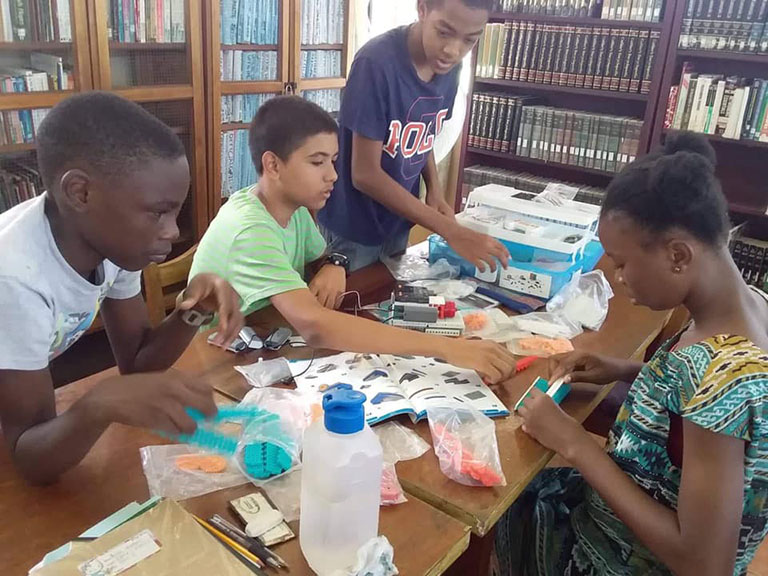Executive Director STEMGuyana
A Science, Technology, Engineering, Mathematics (STEM) curriculum is one vehicle through which children can benefit from a vision of life beyond deprivation and an absence of opportunity. A rounded and enlightening exposure which includes glimpses into what might exist beyond the confines of their own limited circumstances is critical to their growth and development.
Young people who grow up in poor communities are often relegated to institutions of learning which lack resources, including capable alumni support groups and active and supportive parent/teacher organisations. Constraints on spending on education can condemn children to an absence of benefit from enrichment programmes, well-stocked science and computer laboratories and capable teachers and other resources necessary to expose them to quality STEM education experiences.
The importance of children from low-income communities being exposed to STEM enrichment programmes can hardly be overemphasised. The reality is that 80 per cent of new jobs created over the next decade will require STEM-related capabilities including critical thinking capabilities, problem-solving abilities, and a disposition for creativity, enquiry and persistence. Since STEM-related jobs are also among the fastest growing, highest-paying jobs, it is critical that Guyanese youths be prepared to access those jobs.
The problem is that children residing in low-income communities are probably less likely to have a computer in the household, and access to internet connectivity. As a consequence they are less likely to encounter hands-on experiences that expose them to science and technology than their middle-class peers. In the United States the wealthiest 20 per cent of families devote almost seven times the resources to their children’s enrichment activities outside of the school setting than the poorest 20 per cent.
There is no reason to believe that the statistics in Guyana are any different. Additionally, youths from middle- income households in the United States spend 6,000 more hours in after-school and summer learning activities than their peers from low-income households by the time they reach the 6th grade. Here as well, there is no reason to believe that the statistics in Guyana say differently. Over time, it means that children from middle and upper-income families have an advantage in academic preparation which motivates them to pursue higher education and prepares them for advanced study in STEM education, thereby equipping them with a significant academic advantage over their less fortunate peers.
As students advance in school without adequate foundation-related preparation, they fall behind continually and lose confidence in their ability to pursue STEM-related disciplines; circumstances that result in loss of opportunity to access more lucrative careers in STEM-related fields.
Students in Guyana who live in low-income communities can benefit from early exposure, preparation and opportunity to engage in enrichment programmes like after-school STEM clubs, many of which are supported by STEMGuyana and its partners, including the Department of Youth, the National Library and other public and private sector entities in Guyana. Interestingly, what we have discovered is that students from low-income communities are just as competent in coding, logical thinking and robot building and programming as their peers from more affluent communities.
Students who participate in STEM clubs programmes across the country learn to code, conduct research, develop apps, build and programme robots and more importantly strengthen those critical skills needed to make them exceed in any career environment they choose for the future. Accessing STEM enrichment programmes is also a social justice issue. STEM education can be used to scale solutions for social justice issues and citizens who are not affected by social problems tend not to be motivated to innovate the solutions for them.
STEM education preparation must begin early and leaders must find ways to make these programmes enjoyable and engaging if they are to capture the imagination and interest of young people. STEMGuyana along with committed public and private partners and thousands of motivated parents have contributed to the growth of enrichment programmes for Guyanese children. While STEM Guyana still has a long road to travel in terms of strengthening its position and while many clubs are plagued by broken computers, unreliable internet connectivity, and funding challenges, our leaders and partners remain undaunted. Our immediate-term target is to create one hundred STEM clubs across the ten regions of Guyana by the end of 2019.
STEM enrichment programmes for Guyanese children is especially important at this juncture in the country’s history. Such programmes, however, are especially critical for those children in low-income communities. Our hope is that community leaders and parents develop an even greater appreciation of the need to encourage youths to take advantage of these programmes when they become available. Here in Guyana our work is supported by corporate partners whose contributions make what we offer possible. In the period ahead we look forward to broadening the base of our donor group as well as expanding the level of participation in our STEM programme by communities, parents and children.






